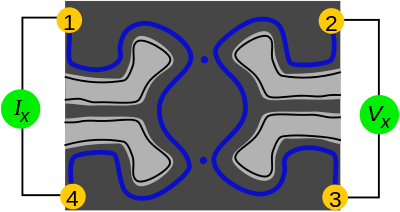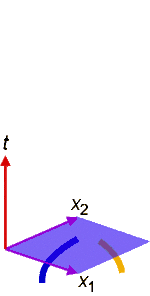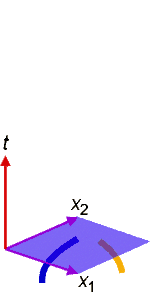Anyon
| Statistical mechanics |
|---|
 |
In physics, an anyon is a type of quasiparticle that occurs only in two-dimensional systems, with properties much less restricted than fermions and bosons. In general, the operation of exchanging two identical particles may cause a global phase shift but cannot affect observables. Anyons are generally classified as abelian or non-abelian. Abelian anyons have been detected and play a major role in the fractional quantum Hall effect. Non-abelian anyons have not been definitively detected, although this is an active area of research.
Abelian anyons
In quantum mechanics, there can exist indistinguishable particles. Unlike in classical mechanics, where each particle is labeled by a distinct state vector , and different configurations of the set of s correspond to different many-body states, in quantum mechanics, the particles are identical, such that exchanging the states of two particles, i.e. , does not lead to a measurably different many-body quantum state.
For example, a system with two indistinguishable particles, with particle 1 is in state ψ1 and particle 2 in state ψ2, has state (in Dirac notation) . Now suppose we exchange the states of the two particles, then the state of the system would be . These two states should not have a measurable difference, so they should be the same vector, up to a phase factor:
In space of three or more dimensions, elementary particles are either fermions or bosons, according to their statistical behaviour. Fermions obey Fermi–Dirac statistics, while bosons obey Bose–Einstein statistics. For bosons, the phase factor is , and for fermions, it is . In particular, this is why fermions obey Pauli exclusion principle: If two fermions are in the same state, then we have
The state vector must be zero, which means it's not normalizable, thus unphysical.
In two-dimensional systems, however, quasiparticles can be observed that obey statistics ranging continuously between Fermi–Dirac and Bose–Einstein statistics, as was first shown by Jon Magne Leinaas and Jan Myrheim of the University of Oslo in 1977.[1] In the case of two particles this can be expressed as
where can be other values than just or . It is important to note that there is a slight abuse of notation in this shorthand expression, as in reality this wave function can be and usually is multi-valued. This expression actually means that when particle 1 and particle 2 are interchanged in a process where each of them makes a counterclockwise half-revolution about the other, the two-particle system returns to its original quantum wave function except multiplied by the complex unit-norm phase factor eiθ. Conversely, a clockwise half-revolution results in multiplying the wave function by e−iθ. Such a theory obviously only makes sense in two-dimensions, where clockwise and counterclockwise are clearly defined directions.
In the case θ = π we recover the Fermi–Dirac statistics (eiπ = −1) and in the case θ = 0 (or θ = 2π) the Bose–Einstein statistics (e2πi = 1). In between we have something different. Frank Wilczek coined the term "anyon"[2] to describe such particles, since they can have any phase when particles are interchanged. Unlike bosons and fermions, anyons have the peculiar property that when they are interchanged twice in the same way (e.g. if anyon 1 and anyon 2 were revolved counterclockwise by half revolution about each other to switch places, and then they were revolved counterclockwise by half revolution about each other again to go back to their original places), the wave function is not necessarily the same but rather generally multiplied by some complex phase (by e2iθ in this example).
We may also use θ = 2π s with particle spin quantum number s, with s being integer for bosons, half-integer for fermions, so that
- or
At an edge, fractional quantum Hall effect anyons are confined to move in one space dimension. Mathematical models of one-dimensional anyons provide a base of the commutation relations shown above.
In a three-dimensional position space, the fermion and boson statistics operators (−1 and +1 respectively) are just 1-dimensional representations of the permutation group (SN of N indistinguishable particles) acting on the space of wave functions. In the same way, in two-dimensional position space, the abelian anyonic statistics operators (eiθ) are just 1-dimensional representations of the braid group (BN of N indistinguishable particles) acting on the space of wave functions. Non-abelian anyonic statistics are higher-dimensional representations of the braid group. Anyonic statistics must not be confused with parastatistics, which describes statistics of particles whose wavefunctions are higher-dimensional representations of the permutation group.[3]:22
Topological equivalence
The fact that the homotopy classes of paths (i.e. notion of equivalence on braids) are relevant hints at a more subtle insight. It arises from the Feynman path integral, in which all paths from an initial to final point in spacetime contribute with an appropriate phase factor. Recall that the Feynman path integral can be motivated from expanding the propagator using a method called time-slicing,[4] in which time is discretized.
In non-homotopic paths, one cannot get from any point at one time slice to any other point at the next time slice. This means that we can consider homotopic equivalence class of paths to have different weighting factors.[5]
So it can be seen that the topological notion of equivalence comes from a study of the Feynman path integral.[3]:28
For a more transparent way of seeing that the homotopic notion of equivalence is the "right" one to use, see Aharonov–Bohm effect.
Experiment

Daniel Tsui and Horst Störmer discovered the fractional quantum Hall effect in 1982. The mathematics developed by Leinaas and Myrheim proved to be useful to Bertrand Halperin at Harvard University in explaining aspects of it. Frank Wilczek, Dan Arovas, and Robert Schrieffer verified this statement in 1985 with an explicit calculation that predicted that particles existing in these systems are in fact anyons.
In 2005 a group of physicists at Stony Brook University constructed a quasiparticle interferometer, detecting the patterns caused by interference of anyons, which were interpreted to suggest that anyons are real, rather than just a mathematical construct.[6] However, these experiments remain controversial and are not fully accepted by the community.
With developments in semiconductor technology meaning that the deposition of thin two-dimensional layers is possible – for example, in sheets of graphene – the long-term potential to use the properties of anyons in electronics is being explored.
Non-abelian anyons
| Unsolved problem in physics: Is topological order stable at non-zero temperature? (more unsolved problems in physics) |
In 1988, Jürg Fröhlich showed that it was valid under the spin-statistics theorem for the particle exchange to be monoidal (non-Abelian statistics).[7] In particular, this can be achieved when the system exhibits some degeneracy, so that multiple distinct states of the system have the same configuration of particles. Then an exchange of particles can contribute not just a phase change, but can send the system into a different state with the same particle configuration. Particle exchange then corresponds to a linear transformation on this subspace of degenerate states. When there is no degeneracy, this subspace is one-dimensional and so all such linear transformations commute (because they are just multiplications by a phase factor). When there is degeneracy and this subspace has higher dimension, then these linear transformations need not commute (just as matrix multiplication does not).
Gregory Moore, Nicholas Read, and Xiao-Gang Wen pointed out that non-Abelian statistics can be realized in the fractional quantum Hall effect.[8][9] While at first non-abelian anyons were generally considered a mathematical curiosity, physicists began pushing toward their discovery when Alexei Kitaev showed that non-abelian anyons could be used to construct a topological quantum computer. As of 2012, no experiment has conclusively demonstrated the existence of non-abelian anyons although promising hints are emerging in the study of the ν = 5/2 FQHE state.[10][11] Experimental evidence of non-abelian anyons, although not yet conclusive and currently contested,[12] was presented in October, 2013.[13]
Fusion of anyons
In much the same way that two fermions (e.g. both of spin 1/2) can be looked at together as a composite boson (with total spin in a superposition of 0 and 1), two or more anyons together make up a composite anyon (possibly a boson or fermion). The composite anyon is said to be the result of the fusion of its components.
If identical abelian anyons each with individual statistics (that is, the system picks up a phase when two individual anyons undergo adiabatic counterclockwise exchange) all fuse together, they together have statistics . This can be seen by noting that upon counterclockwise rotation of two composite anyons about each other, there are pairs of individual anyons (one in the first composite anyon, one in the second composite anyon) that each contribute a phase . An analogous analysis applies to the fusion of non-identical abelian anyons. The statistics of the composite anyon is uniquely determined by the statistics of its components.
Non-abelian anyons have more complicated fusion relations. As a rule, in a system with non-abelian anyons, there is a composite particle whose statistics label is not uniquely determined by the statistics labels of its components, but rather exists as a quantum superposition (this is completely analogous to how two fermions known to have spin 1/2 are together in quantum superposition of total spin 1 and 0). If the overall statistics of the fusion of all of several anyons is known, there is still ambiguity in the fusion of some subsets of those anyons, and each possibility is a unique quantum state. These multiple states provide a Hilbert space on which quantum computation can be done. [14]
Topological basis


In more than two dimensions, the spin–statistics theorem states that any multiparticle state of indistinguishable particles has to obey either Bose–Einstein or Fermi–Dirac statistics. For any d > 2, the Lie groups SO(d,1) (which generalizes the Lorentz group) and Poincaré(d,1) have Z2 as their first homotopy group. Because the cyclic group Z2 is composed of two elements, only two possibilities remain. (The details are more involved than that, but this is the crucial point.)
The situation changes in two dimensions. Here the first homotopy group of SO(2,1), and also Poincaré(2,1), is Z (infinite cyclic). This means that Spin(2,1) is not the universal cover: it is not simply connected. In detail, there are projective representations of the special orthogonal group SO(2,1) which do not arise from linear representations of SO(2,1), or of its double cover, the spin group Spin(2,1). Anyons are evenly complementary representations of spin polarization by a charged particle.
This concept also applies to nonrelativistic systems. The relevant part here is that the spatial rotation group is SO(2) has an infinite first homotopy group.
This fact is also related to the braid groups well known in knot theory. The relation can be understood when one considers the fact that in two dimensions the group of permutations of two particles is no longer the symmetric group S2 (with two elements) but rather the braid group B2 (with an infinite number of elements). The essential point is that one braid can wind around the other one, an operation that can be performed infinitely often, and clockwise as well as counterclockwise.
A very different approach to the stability-decoherence problem in quantum computing is to create a topological quantum computer with anyons, quasi-particles used as threads and relying on braid theory to form stable logic gates.[15][16]
See also
| Look up anyon in Wiktionary, the free dictionary. |
References
- ↑ Leinaas, Jon Magne; Myrheim, Jan (11 January 1977). "On the theory of identical particles" (PDF). Il Nuovo Cimento B. 37 (1): 1–23. Bibcode:1977NCimB..37....1L. doi:10.1007/BF02727953.
- ↑ Wilczek, Frank (4 October 1982). "Quantum Mechanics of Fractional-Spin Particles" (PDF). Physical Review Letters. 49 (14): 957–959. Bibcode:1982PhRvL..49..957W. doi:10.1103/PhysRevLett.49.957.
- 1 2 Khare, Avinash (2005). Fractional Statistics and Quantum Theory. World Scientific. ISBN 978-981-256-160-2. Retrieved May 1, 2011.
- ↑ Lancaster, Tom; Blundell, Stephen J. (17 June 2014). Quantum Field Theory for the Gifted Amateur. Oxford University Press. ISBN 0-19-969932-1.
- ↑ Schulman, L. S. (February 1981). Techniques and Applications of Path Integration. Dover Publications. ISBN 0-471-76450-7.
- 1 2 Camino, Fernando E.; Zhou, Wei; Goldman, Vladimir J. (17 August 2005). "Realization of a Laughlin quasiparticle interferometer: Observation of fractional statistics" (PDF). Physical Review B. 72 (7). arXiv:cond-mat/0502406. Bibcode:2005PhRvB..72g5342C. doi:10.1103/PhysRevB.72.075342. Archived from the original (PDF) on 19 June 2015. , see fig. 2.B
- ↑ Fröhlich, Jürg. "Statistics of fields, the Yang-Baxter equation, and the theory of knots and links." Nonperturbative quantum field theory. Springer US, 1988. 71-100.
- ↑ Moore, Gregory; Read, Nicholas (19 Aug 1991). "Nonabelions in the fractional quantum hall effect" (PDF). Nuclear Physics B. 360 (2–3): 362–396. Bibcode:1991NuPhB.360..362M. doi:10.1016/0550-3213(91)90407-O.
- ↑ Wen, Xiao-Gang (11 February 1991). "Non-Abelian statistics in the fractional quantum Hall states" (PDF). Phys. Rev. Lett. 66 (6): 802–5. Bibcode:1991PhRvL..66..802W. doi:10.1103/PhysRevLett.66.802.
- ↑ Stern, Ady (2010). "Non-Abelian states of matter". Nature. 464 (7286): 187–93. Bibcode:2010Natur.464..187S. doi:10.1038/nature08915. PMID 20220836.
- ↑ An, Sanghun; Jiang, P.; Choi, H.; Kang, W.; Simon, S. H.; Pfeiffer, L. N.; West, K. W.; Baldwin, K. W. (15 December 2011). "Braiding of Abelian and Non-Abelian Anyons in the Fractional Quantum Hall Effect". arXiv:1112.3400 [cond-mat.mes-hall].
- ↑ von Keyserling, Curt; Simon, S. H.; Bernd, Rosenow. "Enhanced Bulk-Edge Coulomb Coupling in Fractional Fabry-Perot Interferometers". Physical Review Letters. 115. arXiv:1411.4654. Bibcode:2015PhRvL.115l6807V. doi:10.1103/PhysRevLett.115.126807.
- ↑ R. L. Willett; C. Nayak; L. N. Pfeiffer; K. W. West (12 January 2013). "Magnetic field-tuned Aharonov–Bohm oscillations and evidence for non-Abelian anyons at ν = 5/2". Physical Review Letters. 111. arXiv:1301.2639 [cond-mat.mes-hall]. Bibcode:2013PhRvL.111r6401W. doi:10.1103/PhysRevLett.111.186401. Cite uses deprecated parameter
|class=(help) - ↑ C. Nayak; S.H. Simon; A. Stern; M. Freedman; S. Das Sarma (28 March 2008). "Non-Abelian Anyons and Topological Quantum Computation". arXiv:0707.1889 [cond-mat.str-el]. Bibcode:2008RvMP...80.1083N. doi:10.1103/RevModPhys.80.1083. Cite uses deprecated parameter
|class=(help) - ↑ Freedman, Michael; Alexei Kitaev; Michael Larsen; Zhenghan Wang (20 October 2002). "Topological Quantum Computation". Bulletin of the American Mathematical Society. 40 (1): 31–38. arXiv:quant-ph/0101025. doi:10.1090/S0273-0979-02-00964-3.
- ↑ Monroe, Don (1 October 2008). "Anyons: The breakthrough quantum computing needs?". New Scientist (2676).
Further reading
- Nayak, Chetan; Simon, Steven H.; Stern, Ady; Freedman, Michael; Das Sarma, Sankar (2008). "Non-Abelian anyons and topological quantum computation". Reviews of Modern Physics. 80 (3): 1083. arXiv:0707.1889v2. Bibcode:2008RvMP...80.1083N. doi:10.1103/RevModPhys.80.1083.
- Wen, Xiao-Gang (15 April 2002). "Quantum orders and symmetric spin liquids" (PDF). Physical Review B. 65 (16): 165113. arXiv:cond-mat/0107071. Bibcode:2002PhRvB..65p5113W. doi:10.1103/PhysRevB.65.165113.
- Stern, Ady (2008). "Anyons and the quantum Hall effect—A pedagogical review" (PDF). Annals of Physics. 323: 204. arXiv:0711.4697v1. Bibcode:2008AnPhy.323..204S. doi:10.1016/j.aop.2007.10.008.